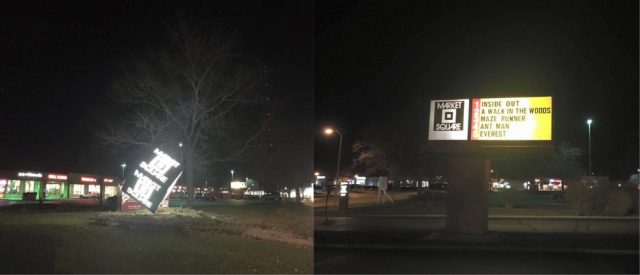
Even for those paying close attention, the conversion from 35mm to DCP on all of Chicago’s multiplex screens happened with very little fanfare.
In December of 2010, Regal City North 14 was playing True Grit on 35mm, but by the time Super 8 came out in June 2011 all screens were DCP – some bitter irony. Kerasotes Webster Place (best worst 7th grade date spot) installed its first digital projector around February 2009, was taken over by Regal in May of 2010, and by August of 2011 all screens had been converted. The AMC-owned Piper’s Alley simply closed in May of 2011 without a word. The Logan Theater (best $3 date spot) closed for renovations in September 2011 and reopened in March 2012 as an all-digital 4-plex, with inaugural DVD and Blu-Ray screenings of The Wizard of Oz and Enter the Dragon – one 35mm Century SA projector and Christie AW3 platter was kept for special events. The Landmark Century was the last major holdout: Samsara screened on 35mm in August 2012, but The Master opened on DCP in September, with all projectors being swapped out and installed the night before. The single-screen Patio Theater closed Argo on November 21, 2012 and added a new, Kickstarter-funded digital projector the following week.
The Music Box and the Gene Siskel Film Center can still run 35mm and do with great frequency for repertory programming, but as far as first-run art-house movies go, the 35mm well pretty much dried up by mid-2012. Any subsequent runs on film would be anomalies, usually at the request of the filmmakers à la Son of Saul or The Love Witch, and many independent and arthouse titles that were shot on film didn’t have the luxury of 35mm release prints (most notably Certain Women, Queen of Earth, the partially-shot-on-65mm Sunset Song).
Did anyone care? At the time I remember expecting a major uprising of cinephiles, projectionists, filmmakers, and exhibitors decrying this swift, violent, and thoughtless destruction of art. The reaction was much more mixed, and in some cases non-existent. So little affection was reserved for multiplex viewing of Hollywood drivel that to many it must have seemed about as important as the brand of nacho cheese changing. A handful of weirdos (myself included) simply stopped going to see first-run movies as often, but for most audiences the change was unnoticed. Some filmmakers were very vocal about the transition. In 2009, at a time when many theaters had both film and digital screens, Quentin Tarantino demanded that any theater that could show Inglourious Basterds on film had to show a print. Paul Thomas Anderson politely, audaciously shot The Master on 65mm in 2012, making the first new 70mm prints for a first-run release since Titanic (1997). Others used the moment to broadcast their unyielding disgust at the format (Steven Soderbergh being among the most petulant, as can be seen in the horrific 2012 documentary Side by Side), and many more seemed resigned to the fact that exhibition on DCP was what would come to pass on all screens and in all markets.
Chicago had outspoken proponents of 35mm exhibition in the press: Ben Kenigsberg covered the state of conversion in a March 2012 article for Time-Out, Michael Phillips pondered the effects of DCP on Drive-Ins in 2013, and Roger Ebert railed against multiplexes’ abhorrently dim digital images in 2011: “Do you remember what a movie should look like? Do you notice when one doesn’t look right? Do you feel the vague sense that something is missing? I do. I know in my bones how a movie should look.” Meanwhile, hundreds of projectors were being hauled off for scrap metal, or more often pushed to the corners of a brightly lit, winding multiplex booths, their sound and power cables unceremoniously snipped and coiled up. One technician friend recounted a story of a theater manager gleefully tipping a Kinoton 35mm projector into a dumpster.
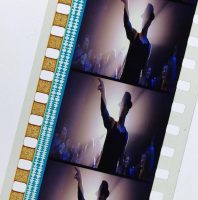
By 2012, seeing a new Hollywood movie movie on 35mm had become a very rare thing. The Gene Siskel Film Center valiantly programmed second run titles on 35mm for as long as they could get them. If you wanted to see Inherent Vice (2014), Irrational Man (2015), To the Wonder (2012), or Lee Daniels’s super-16 masterpiece The Paperboy (2012) on film, the Siskel was the only place it was going to happen. If you wanted to see Lincoln (2012) on 35mm, it would have to be at the Northbrook Public Library. Doc Films programmed their second-run series with as many new 35mm prints as they could get, which on some calendars wasn’t any. Midnight programming at the Music Box gave audiences a rare chance to see Spring Breakers (2013) on 35mm, followed up in 2016 by Mad Max: Fury Road (2015) and Magic Mike XXL (2015), two digital born movies that benefitted tremendously from all the color and contrast that Kodak’s print stocks could afford them.
By the end of 2013, it could no longer be taken for granted that any major studio title would get a 35mm release. Paramount announced Anchorman 2 would be their last 35mm run, though they backtracked on that in a big way with Interstellar, which had over 200 35mm prints in the US, and later on Star Trek: Beyond, Teenage Mutant Ninja Turtles: Out of the Shadows, and Jack Reacher 2. Obsessives would comb the end credits of films for a “print by Fotokem” logo, but even that wasn’t a sure indicator: credit scrolls could be hastily put together from old templates, and many titles still had an SDDS (Sony Dynamic Digital Sound) logo, even though there hadn’t been a SDDS release since February, 2013.
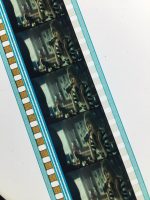
All the while, a small contingent of moviegoers were keeping track of the last remaining venues across the country still showing standard Hollywood fare on 35mm. In 2013, my friend Mike Williamson extolled the virtues of the Glendale Galaxy, which was screening Gravity on 35mm in glorious 2-D: “GIANT screens, huge theatres…No audiences.” The 5-screen Holiday Star Theater in Park Ridge, IL ran 35mm until it closed in September 2013, sadly before we could make it out to see Fast & Furious 6 (2013). Another friend kept track of the Strand Theater in Angola, IN, which was running 35mm until it closed at the end of 2016, including such choice titles as Vacation (2015) and Daddy’s Home (2015). Leonard Maltin wrote a beautiful piece about seeing Jurassic World (2015) at the admittedly crappy but undeniably special Pacific Sherman Oaks 5 in Indiewire: “Imagine my surprise when there were no trailers, just a beat-up Pacific Theaters logo announcing their Feature Presentation followed by the movie itself. I had to pinch myself: this couldn’t be a digital presentation—it had to be on film. And it was.”
Then there was the Silver Cinemas’ Market Square 5-Plex on Odana Road in Madison, WI, which is now the last venue within driving distance of Chicago still running 35mm Hollywood movies (that we can find). Three of the five screens are digital, but auditoriums 1 and 5 are still set up exclusively for film projection. On my last visit, screen 5 was dark: Jack Reacher 2 had just finished its run and was awaiting pickup for its next engagement at god-knows-where, and there were no prints available for the current week. But screen 1 was pure magic. A nice big screen with proper masking, and on it a beautiful, sharp, bright, loud, print of Sully (2016), preceded by a glistening Sprite ad in 35mm and scope, serving as a gentle reminder that (as a Film Society regular once put it) video is not film, DCP is not film, and film is best. Meanwhile, 600 miles away, the Park Ave Cinema in Meadville, PA, opened Sing on 35mm this week – they were kind enough to reply to my facebook inquiry and said that print #11 is “brand new.”
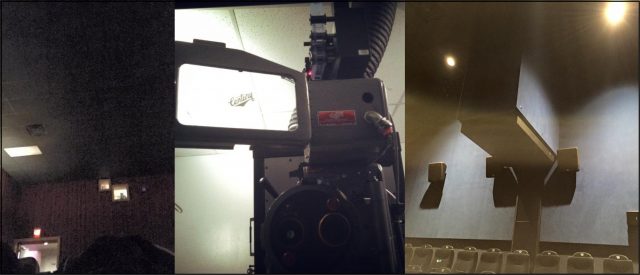
Venues like Market Square and Park Ave wouldn’t have been anything special ten years ago, but now they represent a one-of-a-kind experience. When programmers talk about a rare print, they’re usually thinking of an IB Tech print of Vertigo or The Conversation, but what will become of prints made in past two years? In 2007 the print run for a movie like Sully would have been around 3,500, but the print I saw at Market Square is likely one of less than twenty. As part of its collection of Oscar-nominated films, the Academy Film Archive received 35mm prints of Sully, Fantastic Beasts and Where to Find Them, and La La Land, the last of which screened only twice publicly at the New Beverly. Carol (2015) had a limited run in England on 35mm and only two prints were made, one of which eventually made it over to the Metrograph in New York for a handful of sold out shows. Cinematographer Ed Lachman paid for the prints himself.
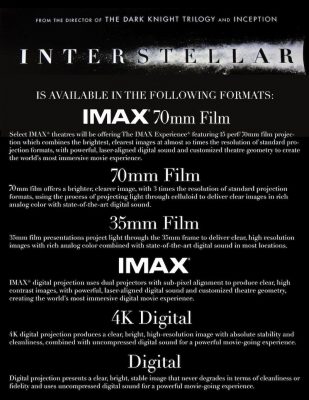
In July 2014, Kodak reached an agreement with Warner Brothers, Sony, Paramount, Fox and Disney to buy an undisclosed minimum amount of film stock for an undisclosed period of time, effectively breathing new life into the company’s film division after emerging from Chapter 11 bankruptcy in 2013. Christopher Nolan’s Interstellar was released a few months later, with “presented in 70mm IMAX film, 70mm film, and 35mm film” taking the place of the “RealD 3D” tag at the end of its trailer (this was especially effective if the trailer was being run on a dimly lit projector at AMC). A little over a year later Quentin Tarantino’s Hateful Eight opened on 100 screens on 70mm, an exceedingly unbelievable event because a few months prior, there were only a couple dozen venues that could show 70mm. Samuel L. Jackson appeared in a Hateful Eight featurette wearing a Kodak hat. The world was saved, for the moment. Warner Brothers followed up with 70mm releases of two of its recent tentpole titles, Batman v. Superman: Dawn of Justice and Fantastic Beasts and Where to Find Them, with Wonder Woman, Skull Island, and Dunkirk slated for later this year.
Film isn’t going anywhere, but it’s never going to be normal again. The small crowds of people seeing Sully at Market Square will be the very last to witness 35mm film projection as a common, no-frills occurrence. No more massive booths with a dozen Century projectors and platters whirring away, and no more 35mm trailers and bumpers, often the most enchanting pieces of glorious cinema detritus. Any repertory or archival prints are now (mostly) recognized as one-of-a-kind objects, rightfully requiring hefty insurance policies and white gloves. Photochemical film exhibition will be alive as long as somebody wants it, but the eventual loss of 35mm as a first- and second-run format is a lousy step backwards. Sully closed at Market Square Thursday, 2/9/2017, and Fantastic Beasts and Where to Find Them opened last Friday, three months after its initial opening weekend; it may well be the last film they screen on 35mm – a rare archival print.
